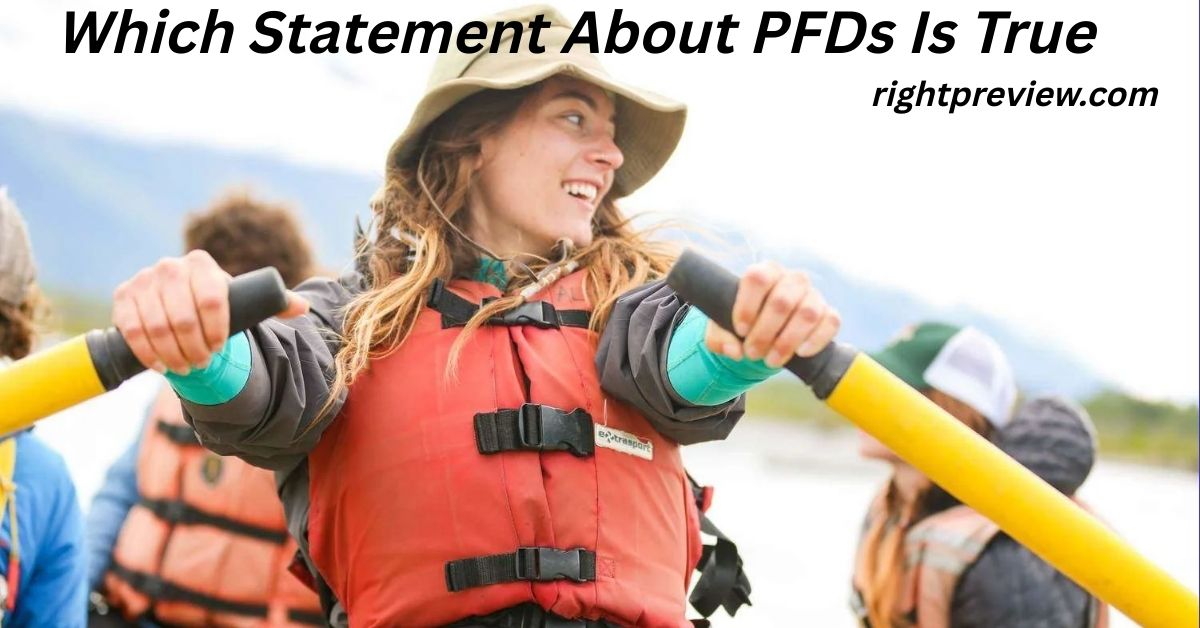Personal Flotation Devices (PFDs) are a crucial part of water safety, helping to keep individuals afloat during water-related emergencies. Whether you’re boating, kayaking, or simply swimming in open water, PFDs play a vital role in preventing drownings and ensuring safe enjoyment of water activities. Despite their widespread use, many people still have questions about PFDs. In this article, we will provide an in-depth, detailed guide that clears up common misconceptions, breaks down the different types of PFDs, explains their safety features, legal requirements, and more. By the end of this article, you’ll be able to confidently answer the question: “Which statement about PFDs is true?”
What Are Personal Flotation Devices (PFDs)?
Personal Flotation Devices (PFDs) are wearable devices designed to help individuals stay afloat in water. The primary purpose of a PFD is to prevent drowning by providing buoyancy and stability, ensuring the wearer stays above water even in the most challenging conditions. There are various types of PFDs tailored for different activities, conditions, and user needs, but all share the same fundamental purpose: water safety.
PFDs are often mistaken for life jackets, but not all PFDs are life jackets. A life jacket is a type of PFD specifically designed to provide the highest level of buoyancy and ensure the wearer remains afloat and positioned face-up, even if unconscious. Other types of PFDs may provide buoyancy in different ways and may be more suitable for active use or specific water activities.

Why Are PFDs Important?
PFDs are lifesaving devices, and their importance cannot be stressed enough. Drowning remains one of the leading causes of death for recreational boaters and water sports enthusiasts. According to the U.S. Coast Guard, the majority of these deaths are preventable with the use of a PFD. Even skilled swimmers can find themselves in dangerous situations. Currents, sudden changes in weather, exhaustion, or even panic can make swimming difficult or impossible, and a PFD ensures you stay afloat until help arrives or you can reach safety.
Also Read: Felixing: The Ultimate Software Solution for Workflow Optimization and Enhanced Communication
Types of PFDs: Which One Is Right for You?
There are five main types of PFDs, each designed to suit specific water activities and environmental conditions. Understanding which type of PFD is best suited for your activity is essential for safety.
Type I: Offshore Life Jackets
Type I PFDs are designed for use in rough, open water. These are the most buoyant PFDs and are often used for offshore boating or deep-sea activities where immediate rescue may not be available. These PFDs provide the highest level of flotation and are designed to turn unconscious individuals face-up in the water. While they tend to be bulkier than other types, their safety features are unmatched in remote or offshore environments.
Key Features:
- Highest buoyancy rating, typically 22 pounds of flotation
- Suitable for rough, open water where rescue might be delayed
- Provides face-up buoyancy even for unconscious users
- Bulky, can be restrictive during physical activity
Best For: Offshore boating, commercial vessels, and emergency situations.
Type II: Near-Shore Life Jackets
Type II PFDs are designed for use in calmer waters, such as lakes, rivers, or inland waters. While they provide less buoyancy than Type I PFDs, they are more comfortable and easier to wear. Type II PFDs are intended for situations where rescue is more likely within a short period of time. They can keep you afloat if you’re conscious but are less effective for unconscious individuals.
Key Features:
- Moderate buoyancy (typically 15.5 pounds of flotation)
- Ideal for calm, inland waters
- Comfortable and less bulky than Type I
- Less effective in rough water or for unconscious individuals
Best For: Boating, fishing, and other water activities in calm, near-shore waters.
Type III: Flotation Vests for Active Use
Type III PFDs are the most commonly used PFDs for recreational activities, such as kayaking, fishing, and water skiing. They provide a balance between buoyancy and comfort, allowing for more mobility than Type I and Type II PFDs. These PFDs are ideal for individuals who are active in the water and able to help themselves in an emergency. However, they do not offer the same face-up flotation as Type I or Type II.
Key Features:
- Adequate buoyancy (typically 15.5 pounds of flotation)
- Comfortable and ideal for active water sports
- Allow for freedom of movement
- Not designed to turn an unconscious person face-up
Best For: Kayaking, canoeing, water skiing, paddleboarding, and other active water sports.
Type IV: Throwable Devices
Type IV PFDs are not worn but are instead thrown to someone who is in distress in the water. These include life rings, cushions, or buoyant cushions that can be tossed to a person in need of flotation. While they are not suitable for general use, they are essential in rescue situations.
Key Features:
- Designed to be thrown to someone in distress
- Provides flotation for those who are not wearing a PFD
- Not worn and cannot be used by an individual during regular water activities
Best For: Rescue situations, boating safety kits, and lifeguard equipment.
Type V: Special-Use Devices
Type V PFDs are designed for specific activities, such as kayaking, water skiing, or windsurfing. These devices are required to be worn during these activities and come with specialized features to suit the unique needs of each sport. For example, Type V PFDs for kayaking are designed to provide buoyancy while allowing full range of motion for paddling.
Key Features:
- Specialized for specific activities
- Provides adequate buoyancy while allowing mobility
- May include additional features, such as hydration packs or pockets
Best For: Kayaking, water skiing, paddleboarding, and other specific water sports.
Debunking Common Myths About PFDs
There are numerous misconceptions about PFDs that can affect safety. Let’s take a look at some of the most common myths:
Myth 1: “I don’t need a PFD if I’m a strong swimmer.”
Fact: Even the best swimmers can find themselves in dangerous situations. Water conditions can change unexpectedly, and a strong swimmer might be caught in currents, tired, or disoriented. A PFD provides vital support and ensures that you remain afloat while you regain control or await rescue.
Myth 2: “All PFDs are the same.”
Fact: PFDs come in different types, each suited for specific conditions. For instance, a Type I PFD is not suitable for active water sports because it’s bulky, but a Type III is designed to allow freedom of movement while still providing buoyancy. It’s crucial to choose the right PFD based on your activity.
Myth 3: “PFDs are only needed for boating.”
Fact: PFDs are necessary for many water activities beyond boating, including kayaking, paddleboarding, fishing, and even swimming in open water. If you’re near or on water, a PFD is always recommended for safety.
Myth 4: “PFDs are uncomfortable, and I don’t need to wear one.”
Fact: Modern PFDs are designed for comfort, with adjustable straps, lightweight materials, and ergonomic designs. Many PFDs are made to allow movement, making them much more comfortable than older models.
Safety Features of Modern PFDs
PFDs today are more than just flotation devices—they come equipped with additional features to enhance safety and usability:
- Buoyancy: The most critical feature of any PFD is its buoyancy. A good PFD should keep you afloat with minimal effort.
- Reflective Strips: Many modern PFDs have reflective materials that enhance visibility in low light or fog, helping rescuers spot you more easily.
- Whistles: Some PFDs come with attached whistles, which can be used to signal for help in emergencies.
- Comfort: Modern PFDs are lightweight and designed for comfort, offering adjustable straps and breathable fabrics.
Legal Requirements for PFDs
Understanding the legal requirements for PFDs is crucial for ensuring you’re in compliance with safety regulations:
Federal PFD Regulations
According to the U.S. Coast Guard, all vessels must have enough PFDs for everyone on board. This applies to recreational boats, commercial vessels, and even kayaks. Additionally, children under the age of 12 are required to wear a PFD while on a vessel, in most cases.
Also Read: Maximize Your Investment Potential with 5StarsStocks.com_ Expert Tips and Winning Strategies
State-Specific PFD Requirements
While federal laws apply universally, states have additional regulations that may require PFDs for specific activities, such as water skiing or paddleboarding. For example, some states may require the use of PFDs on all vessels, regardless of size, while others may only mandate them for specific types of watercraft.
Consequences of Non-Compliance
Failing to wear a PFD when required can lead to fines, penalties, and more severe consequences in the event of an accident. In many states, failure to comply with PFD laws can result in legal action or increased liability for boat owners.
FAQs About which statement about pfds is true
What type of PFD should I use for kayaking?
For kayaking, a Type III or Type V PFD is generally recommended. These types provide the necessary buoyancy and comfort for paddling while allowing freedom of movement.
Can I use a PFD that is not Coast Guard-approved?
No. It’s essential to only use Coast Guard-approved PFDs, as non-approved devices may not meet safety standards and could fail to protect you in an emergency.
What is the most important factor when choosing a PFD?
The most important factor when choosing a PFD is fit. A PFD should fit snugly but comfortably. If the PFD is too loose or too tight, it may not provide the necessary buoyancy or comfort.
How do I maintain my PFD?
Regularly check your PFD for damage, including rips, tears, or wear on the straps. Make sure the flotation material is intact and ensure that the PFD is clean and dry after each use to prevent mold or deterioration.
Are there specific PFDs for children?
Yes. Children should wear a PFD that is specifically designed for their size and weight. There are Type I, II, and III PFDs made for children, which are designed to provide the necessary buoyancy and ensure safety on the water.
Conclusion: Staying Safe on the Water
which statement about pfds is true ? ,Personal Flotation Devices are a vital component of water safety. By choosing the right PFD for your activity, maintaining it properly, and following legal guidelines, you can significantly reduce the risk of accidents and drownings. Always remember: a good PFD can make the difference between life and death in an emergency. Stay safe, and enjoy your time on the water!




